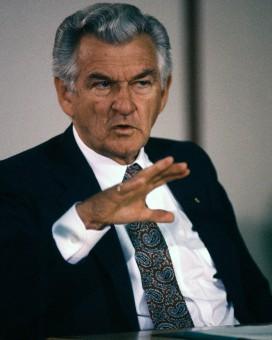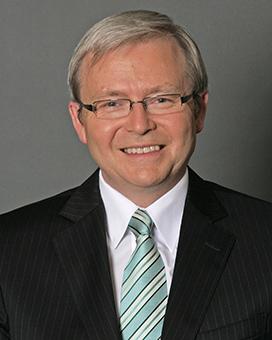Paul John Keating was born in Paddington, Sydney, in 1944. He left school at age 14 and joined the Labor Party the following year. In 1969, aged 25, he won the seat of Blaxland in the federal parliament.
Keating was briefly Minister for Northern Australia in 1975, during the last months of the Whitlam government. He was Treasurer from 1983 to 1991 in the Hawke government, when floating the Australian dollar initiated the process of deregulating the Australian economy.

Prime Minister Bob Hawke and Treasurer Paul Keating at their first Premiers conference, in Canberra on 30 June 1983. NAA: A6135, K8/7/83/118
Early years
Keating was born in Sydney on 18 January 1944, the eldest of 4 children of Min and Matt Keating. His father was a boilermaker and union official, and the family lived in the industrial suburb of Bankstown in Sydney’s south-west. Keating had 3 years of high school at Bankstown’s De La Salle College. On 16 January 1959, he took a job as a pay clerk at Sydney’s electricity authority and joined the Labor Party the same year. Keating went to evening classes for 2 years at Belmore Technical College to finish high school, but did not sit the final exams.
Keating was much more interested in the education he could get from his father’s hero, radical Labor figure Jack Lang. He arranged to meet the 80-year-old Lang in 1962, and then called on him every week to talk Labor politics. In 1964, Keating joined Sydney’s Labor Youth Council (later Young Labor), becoming president in September 1966. As well as managing a rock band, the ‘Ramrods’, Keating took a job as researcher and union advocate with the Federated Municipal and Shire Council Employees Union.
Member for Blaxland 1969
Keating secured pre-selection for the federal seat of Blaxland, the electoral division that included Bankstown, and won the seat at the election on 25 October 1969. He entered parliament in a wave of new Labor backbenchers, when the party increased its House of Representatives seats from 41 to 59. Led by Prime Minister John Gorton, the Liberal–Country National Party Coalition suffered a decrease from 82 to 66 seats. At the next federal election in December 1972, the coalition’s support continued a downward slide. Labor won government with 67 seats in the House of Representatives and Gough Whitlam became Prime Minister.
The 3 years of the Whitlam government provided invaluable experience for both the new Labor members elected in 1969 and 1972, and the veterans. Labor had not governed for 23 years, and not one of Ben Chifley’s ministry remained in parliament.
In January 1975, Keating married Alitalia flight attendant Annita van Iersel in her family’s village in the Netherlands. The couple made their home in Gerard Avenue, Condell Park in Sydney, not far from the Keatings’ family home. Keating was 31 years old, and when he became a minister later that year, he was among the youngest federal ministers in the parliament’s first century.
Minister for Northern Australia 1975
Keating’s opportunity for the front bench came when Minister for Minerals and Energy Rex Connor was required to resign after revelations of negotiations to secure overseas loan funds from unofficial sources. In the subsequent ministerial re-shuffle, Keating replaced Rex Patterson as Minister for Northern Australia on 21 October 1975.
Keating was minister for just 3 weeks. On 11 November 1975, Governor-General Sir John Kerr dismissed the Whitlam government and commissioned Liberal leader Malcolm Fraser to form a government. As Prime Minister, Fraser then sought a double dissolution of the parliament and called an election for 13 December 1975.
In Opposition 1975–83
Labor won only 36 seats at the election and was once again in Opposition. With former ministers now doubling up to cover the portfolio functions, Keating was spokesman in a broad assortment of shadow ministries. He covered Agriculture (January – March 1976), Minerals and Energy (March 1976 – November 1980), National Development (December 1977 – November 1980), Northern Australia (March – November 1980), Resources and Energy (November 1980 – January 1983) and Treasury (January – March 1983).
Keating was active in both the federal parliamentary Labor Party and the New South Wales Labor Party. On 21 September 1979, he was elected president of the state party.
When Gough Whitlam retired from parliament in July 1978, Bill Hayden won the leadership of the parliamentary party. Labor’s electoral reversal in 1975 did not improve in the December 1977 election. In October 1980, Labor made inroads into the Liberal majority, winning 51 seats, including the seat of Wills won by Bob Hawke.
Prime Minister Malcolm Fraser called an election for 5 March 1983, at the same time as the Labor Party leadership was vacated by Bill Hayden in favour of Bob Hawke. Labor’s election campaign was launched by Bob and Hazel Hawke on 16 February at the Sydney Opera House.
Treasurer 1983–91
On 11 March 1983, Bob Hawke was sworn in as Prime Minister. His new ministry included Lionel Bowen as deputy Prime Minister, Bill Hayden as Minister for Foreign Affairs and Paul Keating as Treasurer. Keating’s closest associates in the first ministry were Hayden, Industry Minister John Button, Housing Minister Chris Hurford, Education Minister Susan Ryan and Finance Minister John Dawkins.
Opponents in the House, as well as colleagues in Cabinet, observed Keating’s extreme nervousness in his new role. With only 3 weeks of ministerial experience and no tertiary qualifications, the Treasury portfolio was challenging. John Button recalled that Keating was ‘extraordinarily hesitant’ in his first 6 months, while Opposition frontbencher Andrew Peacock observed how the Treasurer always read from notes, even in Question Time, and from across the table the paper in his hand could be seen shaking as he spoke. Keating’s predecessor, John Howard, had 7 years experience as a minister, 5 of them as Treasurer. Keating saturated himself in the work to try to close the gap between them. John Stone continued as head of Treasury after the change of government and was a valued adviser to the new Treasurer.
In 1983, the Keatings had 3 small children and continued to live in the Sydney suburb of Condell Park. With Labor now in government, the family faced the problem common to front bench parliamentarians. Keating spent much of his time working in Canberra, while his family lived in Sydney. Both John Howard and John Stone encouraged Annita Keating to make the decision to come to Canberra. By mid-1983, the couple had rented a house as their Canberra base, and Keating no longer stayed at the Hotel Kurrajong for his frequent and extended trips to Canberra.
In December 1983, the government made an historic economic change with the decision to float the Australian dollar, rather than have its value tied to another currency or fixed by government regulation. The change was supported by shadow Treasurer John Howard. But the Leader of the Opposition, Andrew Peacock, the National Party and some of Keating’s Labor colleagues opposed the float. It was also against the advice of John Stone, and indicated Keating’s increasing confidence in his portfolio and his drawing advice from other senior Treasury officials like Bernie Fraser.
The currency float was part of a broad financial deregulation program introduced by the Hawke government and guided by Treasurer Paul Keating. It included licensing foreign banks to operate in Australia, and removing direct controls on interest rates and other restrictions that created competitive disadvantage for Australian companies in international markets. Critics pointed to the danger of speculation and of the vulnerability of a globalised economy to market crises. This was demonstrated after the New York stock market slump in October 1987. The very public collapse of some high-profile corporate entrepreneurs in Australia indicated the inadequacy of Australia’s company laws.
Labor had lost much of its majority at the 1984 election, but at the election in July 1987, the Labor government improved its position in the House of Representatives. It continued the deregulation program, abolishing Australia’s 2-airline policy and extending general tariff reductions. With a record third term achieved, the Hawkes were looking at the possibility of securing the rare prime ministerial luxury – choosing their own time to leave office. Paul and Annita Keating were at Kirribilli House on 25 November 1988, when Hawke and Keating talked over the idea of Keating succeeding Hawke after the next election. Their mutual friend, businessman Peter Abeles, and Australian Council of Trade Unions head Bill Kelty were also present.
Labor felt the impact of high interest rates at the March 1990 election – the Liberal Party made significant gains in the House of Representatives, while Labor lost 8 seats.

Treasurer Paul Keating at the National Press Club on budget night, September 1989. NAA: A6135, K15/9/89/28
Lionel Bowen retired at this election and Keating became deputy Prime Minister. When the new ministry was sworn in on 4 April 1990, he had an additional portfolio, as minister assisting the Prime Minister for Commonwealth–state Relations. In an address at the parliamentary Press Gallery’s annual dinner on 7 December 1990, Keating was indirectly critical of Hawke’s leadership – and for good measure, most previous leaders. The speech fanned the flames of speculation about a leadership challenge. Hawke had made no move to retire, as proposed at the Kirribilli House meeting in 1988, and a rift had developed between the Prime Minister and the Treasurer.
By 1991, economic problems had worsened, and Australia was in recession. Keating argued the recession was itself an economic lever that would correct problematic trends – ‘the recession we had to have’.
On 23 May 1991, Keating passed Ben Chifley’s record 2996 days as a federal Labor Treasurer. On 3 June, he stood against Hawke in a Caucus leadership ballot and lost. Keating resigned both his Cabinet posts and returned to the back benches. He made a second challenge 6 months later. This time he won the ballot and the prime ministership.
Sources
- Carew, Edna, Paul Keating: Prime Minister, Allen & Unwin, Sydney, 1992.
- Catley, Bob, Globalising Australian Capitalism, Cambridge University Press, Melbourne, 1996.
- Edwards, John, Keating: The Inside Story, Viking, Melbourne, 1996.
- Gordon, Michael, A True Believer: Paul Keating, University of Queensland Press, St Lucia, 1996.
- Souter, Gavin, Acts of Parliament, Melbourne University Press, Melbourne, 1988.





